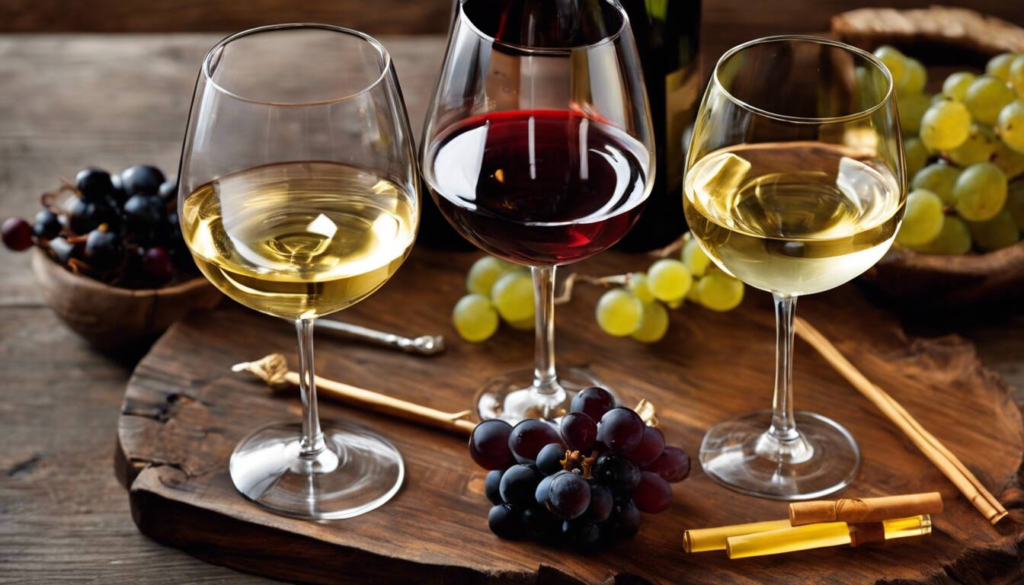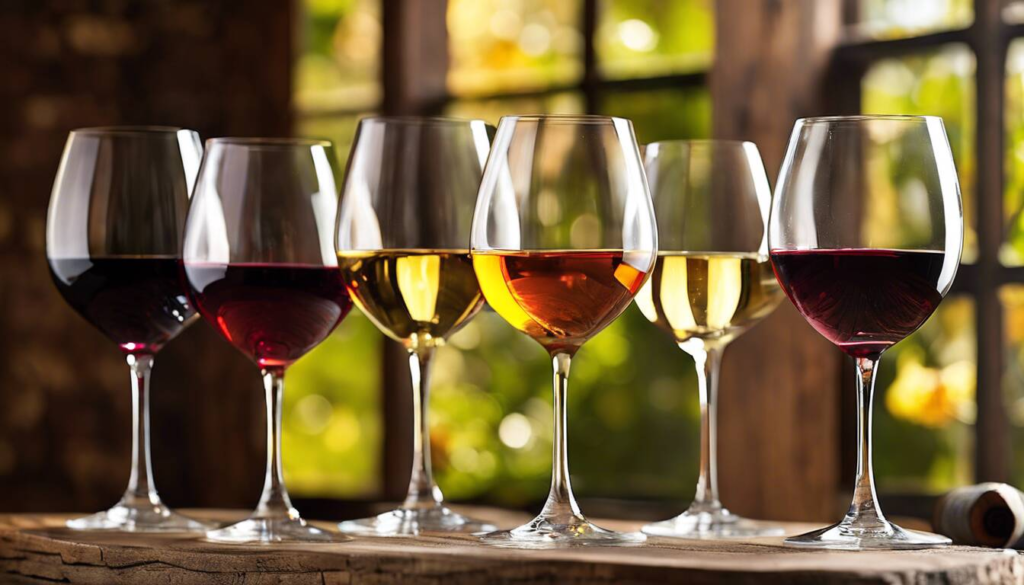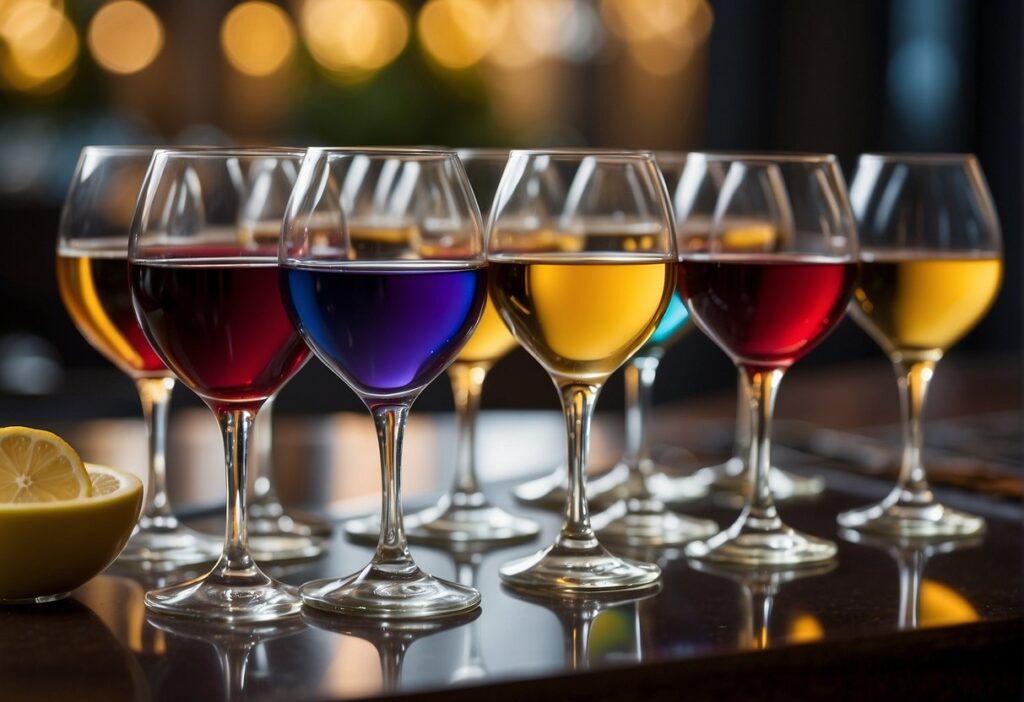Sweet wines have more sugar left in them after fermentation, giving them a noticeably sugary taste. Dry wines, on the other hand, have almost all their sugar converted into alcohol during this process, making them less sugary to the palate. People often link sweeter wines like Moscato or Port with dessert, while dry wines might be paired with a savory food like steak. But, pairing isn’t always as straightforward or predictable. For instance, a glass of icy sweet Riesling can surprisingly wash down a spicy Asian meal quite well! Understanding these nuanced dining combinations boils down to exploring different tastes – an exciting adventure awaits!
Some examples of sweet wine varietals include Riesling, Moscato, and Port, while dry wine varietals include Chardonnay, Sauvignon Blanc, and Cabernet Sauvignon. Keep in mind that sweetness levels can vary even within the same varietal due to winemaking techniques.

Sweet vs. Dry: Unveiling Wine Varietals
When it comes to wine, the battle between sweet and dry can be both complex and delightful. Each type holds its distinct charm, appealing to a broad array of palates and complementing a variety of dishes. To truly understand and appreciate these wine varietals, it’s crucial to explore their inherent characteristics in detail, from taste to aroma and everything in between.
Sweet Wine Varietals Starting with sweet wines, these varietals are known for their lush and pleasing sweetness. Wines like Riesling, Moscato, or Port are excellent examples of this category. They typically boast a higher residual sugar content ranging from 35-120 grams per liter, giving them their distinctive sweetness.
On the palate, sweet wines carry bold fruit flavors and are often described as being juicy and luscious. They pair exceptionally well with desserts or spicy dishes, effectively balancing out their boldness.
Dry Wine Varietals In contrast, dry wines such as Chardonnay, Sauvignon Blanc, or Cabernet Sauvignon tend to have minimal residual sugar content, lingering around 0-4 grams per liter. These wines are valued for their crispness and acidity rather than sweetness.
Their flavor profile leans more towards subtle fruitiness and can also showcase unique herbaceous or mineral notes depending on the varietal. Dry wines are versatile when it comes to food pairing, offering an excellent match for an extensive range of cuisines.
Understanding the differences between sweet and dry wine varietals plays a pivotal role in honing your appreciation for wine. Tasting and savoring each type will enable you to discern the nuances that make them distinct.
Now that we’ve gained insight into the unique attributes of sweet and dry wine varieties, let’s explore the art of food pairing to uncover the perfect match for your next dining experience.
Understanding Sweet Wine Varietals
Sweet wine varietals offer a diverse spectrum of flavors, with each possessing its own unique characteristics and appeal. For example, Riesling is celebrated for its aromatic nature, balancing vibrant acidity with luscious sweetness, making it suitable for a wide range of dishes. Whether it’s a zesty lemon tart or a spicy Thai curry, Riesling’s versatility complements various flavors with finesse.
On the other hand, Moscato is adored for its sparkling and light-bodied nature, boasting tropical fruit notes and a refreshing finish, ideal for sunny afternoons or as a delightful pairing with fruity desserts such as peach cobbler or mixed berry pavlova.
Moving on to the regal Sauternes, this French dessert wine captivates aficionados with its luxurious sweetness and velvety texture. Crafted from grapes affected by noble rot, Sauternes offers a rich symphony of honeyed apricot, marmalade, and delicate spice, making it an exquisite accompaniment to decadent foie gras or indulgent crème brûlée.
It’s important to note that these sweet wines encompass a broad array of styles, offering something for every palate. From the vibrant freshness of late-harvest Chenin Blanc to the opulent and intense flavors of Gewürztraminer, there’s a sweet wine varietal waiting to be discovered by every discerning wine enthusiast.
Exploring the nuances of sweet wine varietals not only reveals their diverse flavor profiles but also unveils the captivating artistry behind their creation. Let’s dive deeper into the intricate process of crafting these delightful libations and explore how they pair harmoniously with an array of delectable cuisines.
Digging into Dry Wine Varietals
When it comes to dry wines, the absence of sweetness allows for a completely different tasting experience. These wines are known for their more austere, less sweet taste profile, emphasizing the grape’s natural flavors and the impact of winemaking techniques. Dry wines are often celebrated for their diverse range of flavors, from crisp and acidic to bold and full-bodied.
Take, for example, the renowned Chardonnay. This varietal is often associated with a dry taste profile due to its minimal residual sugar content. Chardonnay lovers appreciate its versatility, ranging from light and zesty to rich and buttery, depending on where it is grown and how it is crafted. The absence of sweetness in dry Chardonnay allows the complexities of the grape and the influence of oak aging to shine through, creating a balanced and nuanced drinking experience.
Similarly, dry red wine varietals like Cabernet Sauvignon and Merlot are prized for their elegance and depth. These wines showcase a harmonious interplay of tannins, acidity, and fruit flavors without the interference of sweetness. The result is a bold, structured palate that captures the essence of the grape and the unique characteristics imparted by the terroir.
For instance, Cabernet Sauvignon’s dry nature accentuates its distinct notes of blackcurrant, cedar, and savory spices, enveloped in firm tannins that lend structure and age-worthiness to the wine. Meanwhile, Merlot’s dry profile allows its plush texture and luscious dark fruit flavors to take center stage, offering a velvety smoothness that is both approachable and complex.
Understanding the unique attributes of dry wine varietals provides insight into their diverse flavor profiles and showcases their ability to capture the essence of the grape variety and winemaking practices.
To grasp further insights into distinguishing characteristics of sweet wines that set them apart on your taste journey, let’s now turn our attention to exploring characteristic insights of sweet wines.
Characteristic Insights of Sweet Wines
When it comes to sweet wines, a key factor that distinguishes them is their aromatic intensity. The fragrance of sweet wines often carries an alluring blend of floral and fruity notes that gracefully dance on the nose. These intoxicating aromas create a sensory experience that can be as delightful as it is captivating. For instance, you might pick up whiffs of ripe peaches, apricots, or a luscious floral bouquet when savoring a glass of Moscato.
This alluring aromatic intensity not only enhances the overall tasting experience but also makes sweet wines versatile in their pairing options. The pronounced flavors and scents add depth to the sip and make these wines stand out on their own. They can also be wonderfully paired with desserts, creating harmonious flavor combinations by complementing the sweetness of the wine with the sweetness of the dish. Picture this: a velvety vanilla custard paired with a lusciously sweet Sauternes — a match made in heaven indeed.
Moving beyond scent, another defining characteristic of sweet wines is their luscious mouthfeel. The residual sugar in these wines contributes to a rich, velvety texture that coats the palate and creates an indulgent sensation with each sip. This luxurious mouthfeel adds a layer of opulence to the tasting experience, giving rise to an almost decadent sensation as the wine glides smoothly across the tongue.
As you savor a glass of sweet wine, you might notice how it envelops your palate in a soft, velvety embrace, leaving behind a lingering sweetness that dances on your taste buds. This lush mouthfeel not only enhances the overall sensorial pleasure but also provides a unique textural dimension that sets sweet wines apart. To put it simply: it’s like experiencing a deliciously smooth and creamy dessert in liquid form.
With their aromatic allure and luscious mouthfeel, sweet wines offer a multi-dimensional tasting experience that can transform any occasion into a memorable one.
Exploring Attributes of Dry Wines

When discussing dry wines, it’s important to recognize their extraordinary ability to mirror the terroir – the natural environment where grapes are grown, in a remarkably expressive way. It’s as if each sip transports you to the vineyard itself, allowing you to sense the earth and sun that nurtured the grapes.
Wine aficionados often relish deciphering these tantalizing and subtle cues, much like unraveling the layers of a timeless piece of art. This connection between the wine and its origin adds profound depth to the drinking experience, enriching it with a story worth savoring.
Consider two Chardonnays—one from the cool regions of Chablis and another from sunny California. The former is characterized by its lean minerality and bright citrus notes borne out of its chalky soil and brisk climate, while the latter embraces richer tropical fruit profiles and buttery textures influenced by California’s warm sunshine.
Furthermore, when it comes to food pairing, dry wines offer an incredible versatility that makes them a fantastic match for a wide range of dishes. Their acidity and lack of sweetness lend themselves beautifully to balancing flavors on the plate.
Versatile Food Pairing
From delicate seafood to hearty red meats, there’s a dry wine for every occasion. Its clean finish and refreshing qualities make it an ideal companion for pasta dishes while its structured tannins play harmoniously with roast meats.
Whether it’s a flaky fillet of fish or a succulent cut of steak, dry wines bring out the best in the meal without overpowering its delicate nuances.
In essence, these wines don’t just enhance the dining experience; they elevate it, turning an ordinary meal into an extraordinary sensory journey.
The innate ability of dry wines to artfully mirror their terroir while effortlessly complementing an array of cuisines makes them an alluring choice for both seasoned connoisseurs and adventurous enthusiasts alike.
Excited about understanding how to pair food with wines? Let’s continue our exploration into creating delightful culinary experiences with different wine varietals in our next section.
Food Pairing Essentials with Wine Varietals
Food and wine each have their unique characteristics and flavors, and when paired thoughtfully, they can come together to create a sumptuous dining experience. The interplay between sweet and dry wine varietals adds an intriguing dimension to the art of food pairing, allowing for a harmonious blend of tastes and textures that complement each other.
When it comes to sweet wines, their high residual sugar content allows them to lend a delightful contrast to rich desserts. For instance, a lusciously sweet Riesling can beautifully offset the richness of a creamy cheesecake or crème brûlée. These wines are also perfect for pairing with spicy dishes, as the sweetness helps balance the heat. Think of enjoying a glass of Moscato with a fiery Thai curry – the sweet notes of the wine tone down the spiciness, creating a balanced and enjoyable experience.
On the other hand, dry wines are known for their remarkable ability to complement savory dishes. Whether it’s a herb-infused grilled seafood platter, roasted vegetables with earthy undertones, or a carefully curated charcuterie board, dry wines can elevate these savory delights to new heights. Consider serving a crisp Sauvignon Blanc with a fresh seafood dish or a rich Chardonnay with succulent roasted chicken to accentuate the flavors.
For those who prefer red wines, the versatile Cabernet Sauvignon with its elegant dryness pairs exquisitely with hearty steaks and grilled meats. Its structure and tannins provide a beautiful counterbalance to the rich flavors of well-marbled beef.
Pairing food and wine isn’t just about finding good combinations – it’s also about enhancing both the taste profile of the food and the wine itself.
The Perfect Harmony Between Flavors
By mastering the art of food and wine pairing, you open your palate to incredible gastronomic experiences where every sip and every bite complements and enhances each other. The intricate dance of flavors creates moments that are far more memorable than enjoying each individually.
It’s important to remember that personal preferences play a significant role in food and wine pairings. While some may love a specific red wine alongside a certain dish, others may find greater pleasure in experimenting with contrasting flavors.
For those seeking comprehensive food and wine pairing recommendations tailored for beginners and enthusiasts alike, visiting Wine Uncovered is highly recommended. Their detailed guides cover everything from classic pairings to innovative combinations, ensuring that everyone can find their perfect harmony between flavors and textures.
Enhancing your dining experience through thoughtful food and wine pairing adds an extra layer of enjoyment to every meal. Cheers to exploring new flavor combinations and elevating your culinary adventures!

